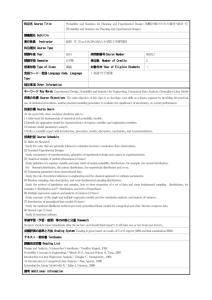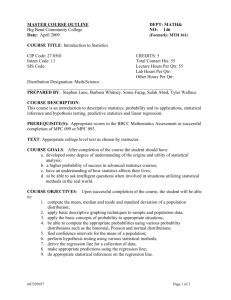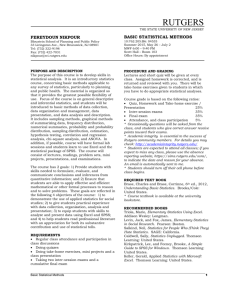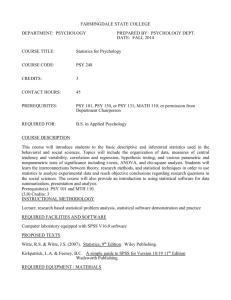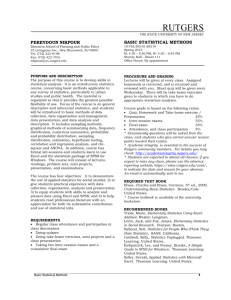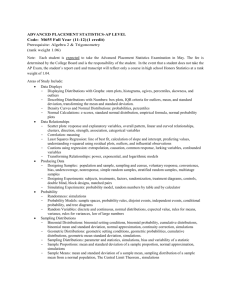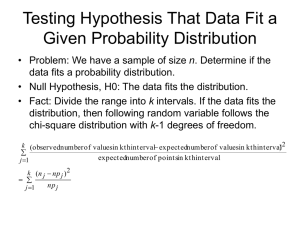MTH 3109
advertisement
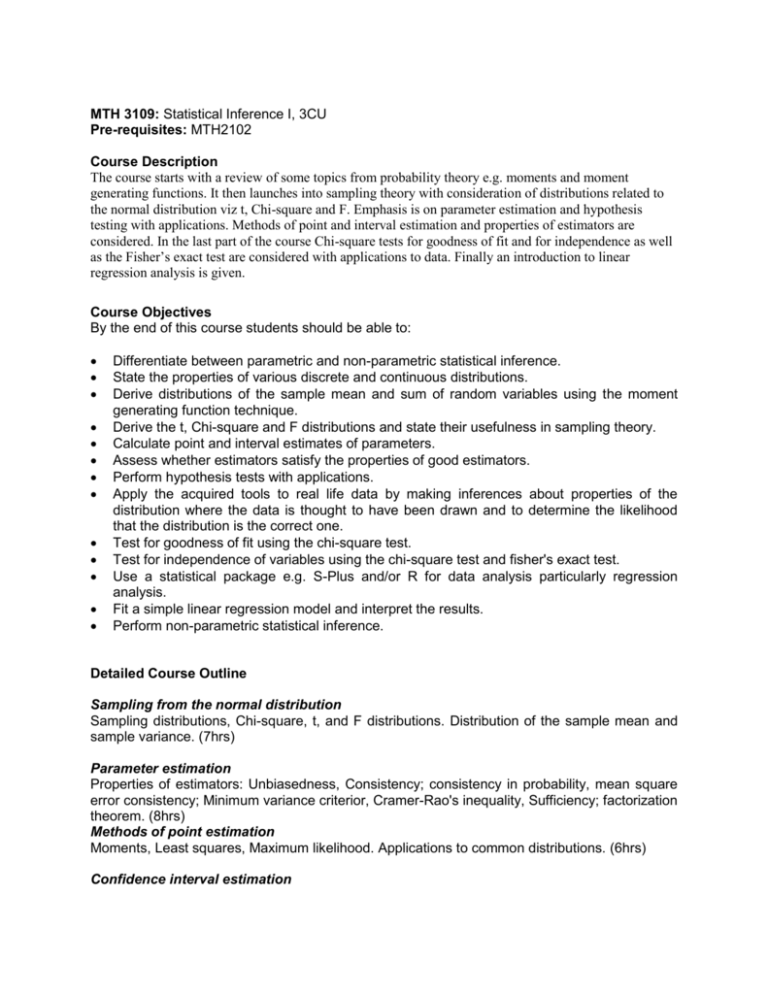
MTH 3109: Statistical Inference I, 3CU Pre-requisites: MTH2102 Course Description The course starts with a review of some topics from probability theory e.g. moments and moment generating functions. It then launches into sampling theory with consideration of distributions related to the normal distribution viz t, Chi-square and F. Emphasis is on parameter estimation and hypothesis testing with applications. Methods of point and interval estimation and properties of estimators are considered. In the last part of the course Chi-square tests for goodness of fit and for independence as well as the Fisher’s exact test are considered with applications to data. Finally an introduction to linear regression analysis is given. Course Objectives By the end of this course students should be able to: Differentiate between parametric and non-parametric statistical inference. State the properties of various discrete and continuous distributions. Derive distributions of the sample mean and sum of random variables using the moment generating function technique. Derive the t, Chi-square and F distributions and state their usefulness in sampling theory. Calculate point and interval estimates of parameters. Assess whether estimators satisfy the properties of good estimators. Perform hypothesis tests with applications. Apply the acquired tools to real life data by making inferences about properties of the distribution where the data is thought to have been drawn and to determine the likelihood that the distribution is the correct one. Test for goodness of fit using the chi-square test. Test for independence of variables using the chi-square test and fisher's exact test. Use a statistical package e.g. S-Plus and/or R for data analysis particularly regression analysis. Fit a simple linear regression model and interpret the results. Perform non-parametric statistical inference. Detailed Course Outline Sampling from the normal distribution Sampling distributions, Chi-square, t, and F distributions. Distribution of the sample mean and sample variance. (7hrs) Parameter estimation Properties of estimators: Unbiasedness, Consistency; consistency in probability, mean square error consistency; Minimum variance criterior, Cramer-Rao's inequality, Sufficiency; factorization theorem. (8hrs) Methods of point estimation Moments, Least squares, Maximum likelihood. Applications to common distributions. (6hrs) Confidence interval estimation One parameter case, application to sampling from nomral population. Estimation of mean and variance for one and two samples. (6hrs) Hypothesis testing Null and alternative hypothesis, simple and composite hypothesis, critical regions, power and size of a test, best critical region, simple likelihood ratio test, most powerful test, applications to simple cases - normal distribution. (8hrs) Chi-square test Contingency tables, goodness of fit test, fisher's exact test. (4hrs) Linear Regression Relationships between variables, transformations to linearity, residual and regression sums of squares, analysis of variance in simple linear regression. (6hrs) Reading List The reading list will include but is not limited to the following texts. Notes prepared by the lecturer. An Introduction to Mathematical Statistics and its Applications by Larsen, R. J. and Marx, M. L. Mathematical Statistics by Freund, J. E. Probability and Statistics by Degroot, M. H. Mathematical Statistics and Data Analysis, 2nd Edition by Rice, J. A. Introduction to Linear Regression Analysis, 2nd Edition, Wiley, 1992. by Montgomery, D.C. & Peck, E.A. Applied Linear Regression, 2nd Edition, Wiley, 1985, by Weisberg, S. Modern Applied Statistics with S, 4th Edition, Springer, 2003 by Venables, W.N. & Ripley, B.D. Learning Outcome o Differentiate between parametric and non-parametric statistical inference. o State the properties of various discrete and continuous distributions. o Derive distributions of the sample mean and sum of random variables using the moment generating function technique. o Derive the t, Chi-square and F distributions and state their usefulness in sampling theory. o Calculate point and interval estimates of parameters. o Assess whether estimators satisfy the properties of good estimators. o Perform hypothesis tests with applications. o Apply the acquired tools to real life data by making inferences about properties of the distribution where the data is thought to have been drawn and to determine the likelihood that the distribution is the correct one. o Test for goodness of fit using the chi-square test. o Test for independence of variables using the chi-square test and fisher's exact test. o Use a statistical package e.g. S-Plus and/or R for data analysis particularly regression analysis. o Fit a simple linear regression model and interpret the results. o Perform non-parametric statistical inference.
